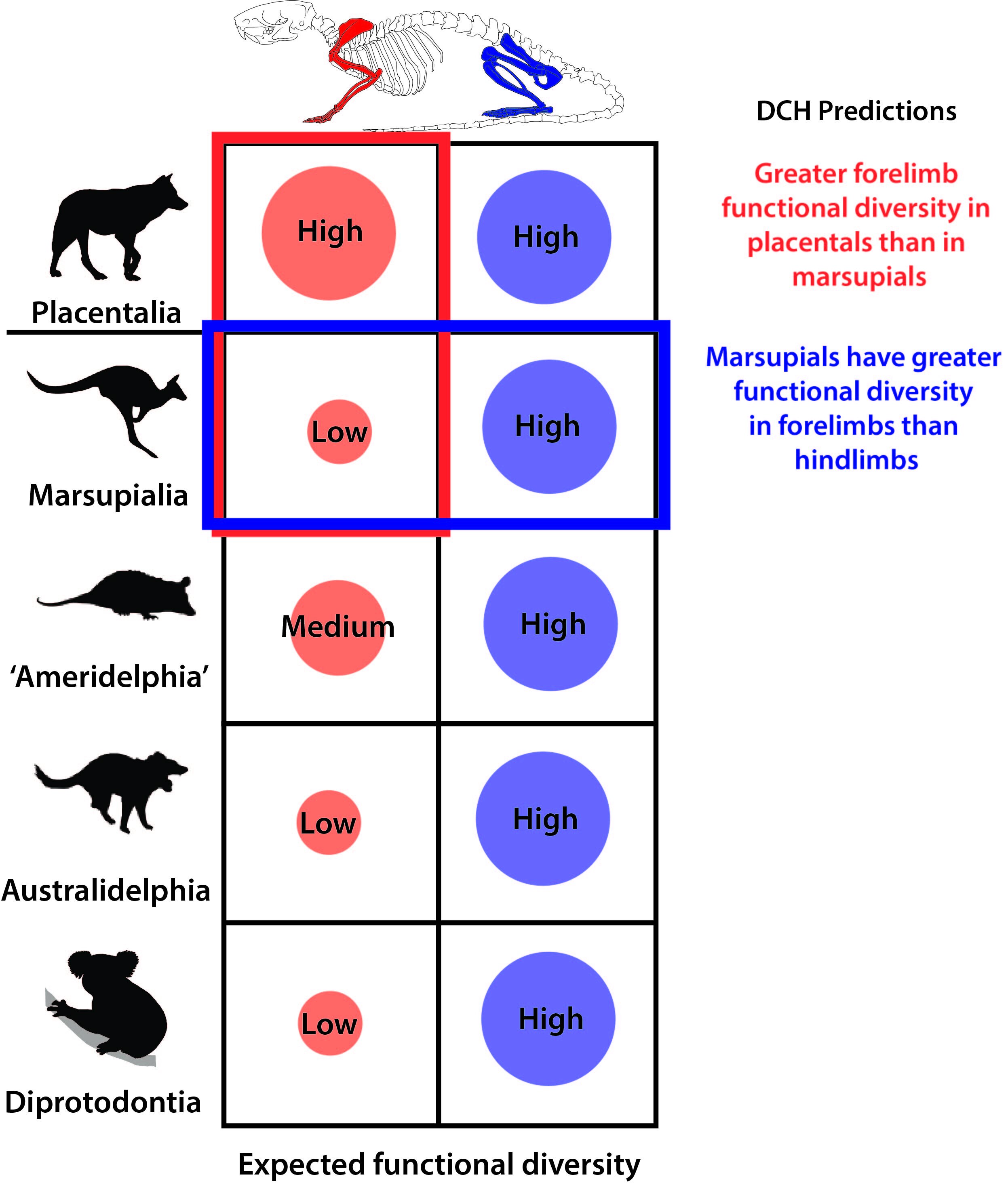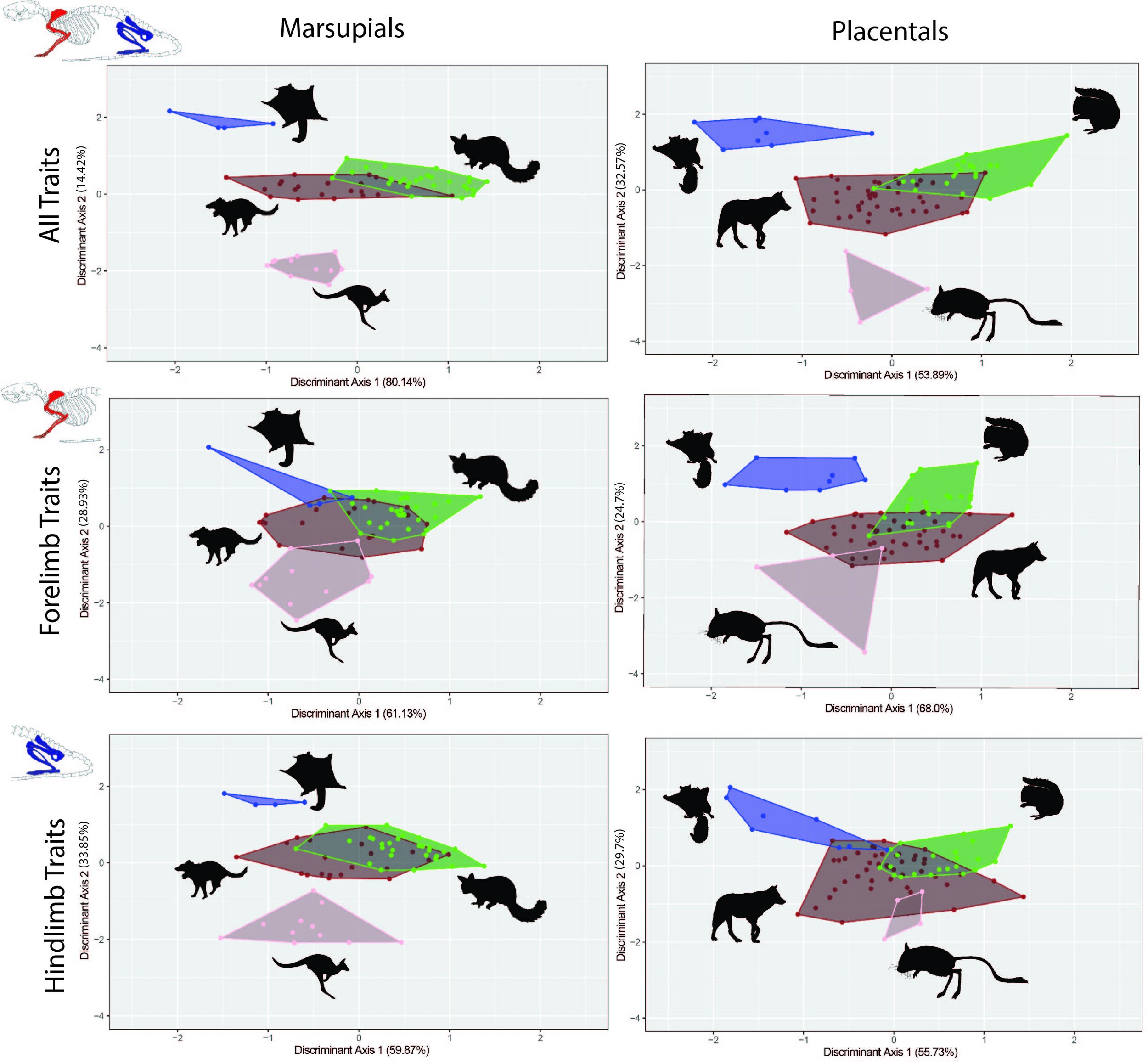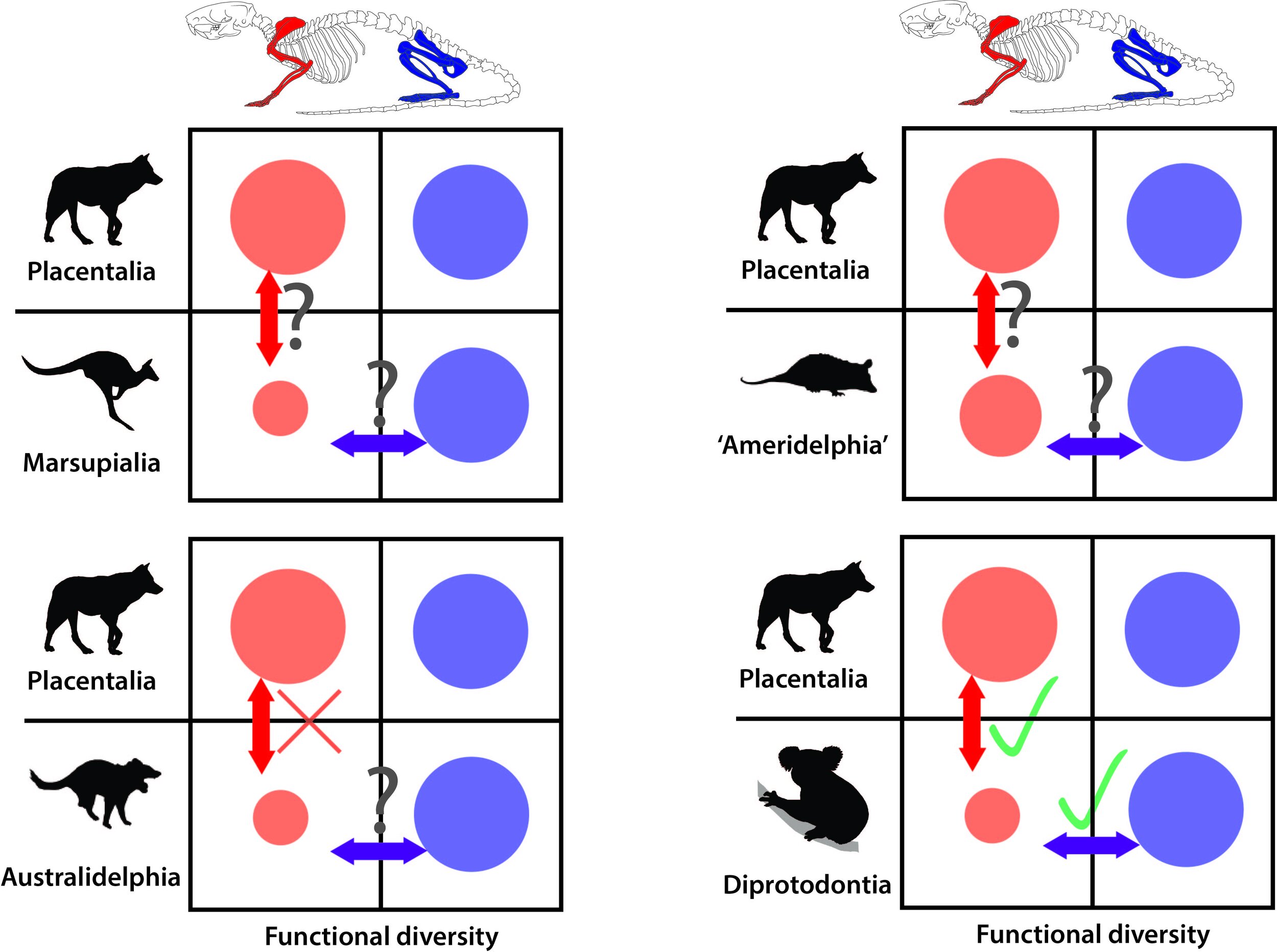
Developmental Constraints in Marsupial Locomotion
I published a first-author paper in the Biological Journal of the Linnean Society revisiting the classic question: why don’t we see any marsupial bats or whales?
Abstract: Extant marsupials are less ecologically diverse than placentals, and this is reflected by placentals exhibiting a greater diversity of locomotor modes, including powered flight and fully aquatic swimming. One proposed explanation for this discrepancy is that the development of more disparate marsupial forelimbs is prevented by the neonate’s crawl to the pouch, which requires precocious forelimb development for climbing adaptations. To test predictions of this Developmental Constraint Hypothesis (DCH), we pursue a comparative morphometric study on osteological traits of mammalian limbs, with an emphasis on functional differentiation of marsupial limbs among locomotor modes. We apply multivariate analyses to a large dataset of limb metrics and a diverse sample of mammals, with the placental sample limited to taxa whose locomotor modes are exhibited in marsupials. Overall, we do not find consistent evidence in support of the DCH. Diprotodontia serves as an exception, with comparisons of their forelimbs to hind limbs supporting the DCH. Our results suggest that developmental constraints on marsupial forelimbs may have limited marsupial diversity to some degree. Despite this, the marsupial locomotor groups show unexpectedly high levels of morphological differentiation relative to placentals of the same locomotor modes, indicating that ecological functions may overcome developmental constraints on a macroevolutionary scale.

Figure 1. Functional diversity patterns in skeletal limb morphologies as predicted by the Developmental Constraint Hypothesis (DCH). The DCH predicts that morphological disparity and functional diversity are constrained by precocial forelimb development in marsupials due to the necessity for the neonatal crawl. This can be tested by morphometric comparison between forelimbs and hind limbs, between placentals and marsupials, and among marsupial groups with varying intensity of crawls. The DCH predicts that marsupial forelimbs have lower functional diversity levels than that of placental forelimbs. Ameridelphian marsupials have a less rigorous neonatal crawl than those of Australidelphia and thus are predicted to have relatively greater forelimb disparity than australidelphians. Silhouette images are from www.phylopic.org. Marsupialia, ‘Ameridelphia’ and Australidelphia images by Sarah Werning (CC BY 3.0; http://creativecommons.org/ licenses/by/3.0/). All other images are not copyrighted.

Figure 2. Phylogeny of the taxa used in the analyses of this study, pruned from a maximum clade credibility tree based on a sample of trees from Upham et al. (2019). Silhouettes are from www.phylopic.org. The Paucituberculata, Microbiotheria, Dasyuromorphia, Notoryctemorphia and Didelphimorphia images are by Sarah Werning (CC BY 3.0; http://creativecommons. org/licenses/by/3.0/). All other silhouette images are not copyrighted.

Figure 3. The flexible discriminant analysis (FDA) morphospace plots of the first two discriminant axes for marsupials and placentals, which are classified into four locomotor modes. These analyses demonstrate that the terrestrial, arboreal, gliding and saltatorial locomotor modes can be sufficiently distinguished by our limb skeletal measurements for the small to medium-sized marsupials and placentals (< 40 kg) in our sample. The different colours represent different locomotor modes, using the same colour legend as in Figure 2. Percentages represent the amount of between-group variance explained by each axis. Petaurus, Macropus and Sarcophilus silhouettes are by Sarah Werning, and the Glaucomys silhouette is by Chloé Schmidt (CC BY 3.0; http://creativecommons.org/licenses/by/3.0/). All other silhouettes are not copyrighted.

Figure 4. Comparison of morphological disparity (variance) in forelimb, hind limb and all limbs between placentals and marsupials, and among different marsupial groups. The forelimb–hind limb discrepancy in trait variance in ‘Ameridelphia’ and in Didelphimorpha is closest to the pattern of placentals (i.e. similar disparity levels for forelimbs and hind limbs). The forelimb disparity (variance) is most comparable between diprotodontian marsupials and placentals. These two observations on disparity pattern are inconsistent with DCH expectations. However, forelimb–hind limb discrepancies in Australidelphia and Diprotodontia clades are consistent with DCH expectations.

Figure 5. Summary of test results on the predictions of the Developmental Constraint Hypothesis (DCH), at different phylogenetic levels. The DCH is somewhat supported by forelimb–hind limb comparison within placentals, within marsupials and within subclades of marsupials, but we find little support for the DCH in comparisons of placentals either to marsupials as a whole, or to subclades of marsupials. The size of the red and blue circles represents expected functional diversity, as outlined in Figure 1. Check marks indicate greater support for the DCH, ‘X’s indicate a failure to support the DCH and question marks indicate mixed support for the DCH. The arrows indicate the groups being compared that correspond to each mark, with red arrows being between-group comparisons, while purple arrows are within-group comparisons. Marsupialia, ‘Ameridelphia’ and Australidelphia images are by Sarah Werning (CC BY 3.0; http://creativecommons.org/licenses/by/3.0/). All other images not copyrighted.